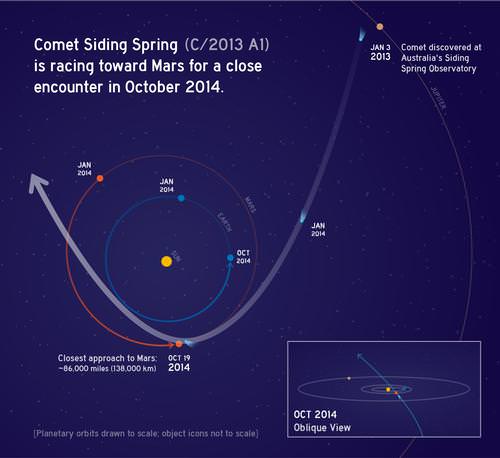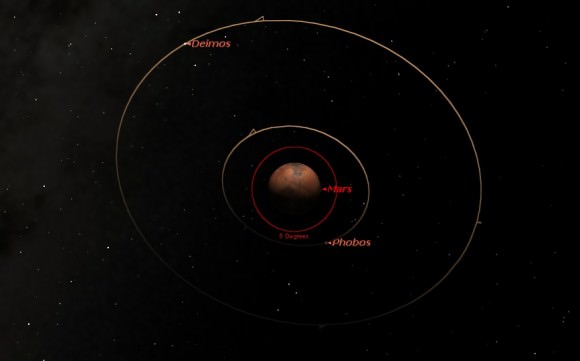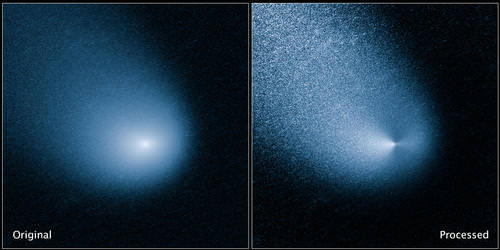It may be the chance of a lifetime for planetary science.
This October, a comet will brush past a planet, giving scientists a chance to study how it possibly interacts with a planetary atmosphere.
The comet is C/2013 A1 Siding Spring, and the planet in question Mars. And although an impact of the comet on the surface of the Red Planet has long been ruled out, a paper in the May 2014 issue of Icarus raises the interesting possibility of possible interactions of the coma of A1 Siding Spring and the tenuous atmosphere of Mars. The study comes out of the Department of Planetary Sciences at the University of Arizona, the Belgian Institute for Space Aeronomy, the Institut de Planétologie et d’Astrophysique de Grenoble at the Université J. Fourier in France, and the Cooperative Institute for Research in Environmental Sciences at the University of Colorado in Boulder.
For the study, researchers considered how active Comet A1 Siding Spring may be at the time of closest approach on October 19th, 2014.
Discovered early last year by Robert McNaught from the Siding Spring Observatory in Australia, Comet A1 Siding Spring created a stir in the astronomical community when it was found that it will pass extremely close to Mars later this year. Further measurements of its orbit have since ruled this possibility out, but its passage will still be a close one, with a nominal passage of 138,000 kilometres from Mars. That’s about one third the distance from Earth to the Moon, and 17 times closer than the nearest recorded passage of a comet to the Earth, Comet D/1770 L1 Lexell in 1780. Mars’ outer moon Deimos has an orbital distance of about 23,500 kilometres.

And although the nucleus will safely pass Mars, the brush with its extended atmosphere might just be detectable by the fleet of spacecraft and rovers in service around Mars. At a distance of 1.4 Astronomical Units (A.U.) from the Sun during the encounter, the vast coma is expected to be comprised primarily of H2O. At an input angle of about 60 degrees, penetration was calculated in the study to impinge down and altitude of 154 kilometres to the topside of the Martian ionosphere, in the middle of the thermosphere.
Such an effect should linger for just over 4 hours, well over the interaction period of Mars’ atmosphere with the coma of just over an hour, centered on 18:30 UT on October 19th, 2014.
What kind of views might missions like HiRISE and MSL get of the comet remains to be seen, although NEOWISE and Hubble are already monitoring the comet for enhanced activity. The Opportunity rover is also still functioning, and Mars Odyssey and ESA’s Mars Express are still in orbit around the Red Planet and sending back data. But perhaps the most interesting possibilities for observations of the event are still en route: India’s Mars Orbiter Mission and NASA’s MAVEN orbiter arrive just before the comet. MAVEN was designed to study the upper atmosphere of Mars, and carries an ion-neutral mass spectrometer (NGIMS) which could yield information on the interaction of the coma with the Martian upper atmosphere and ionosphere. The NGIMS cover is slated for release just two days before the comet encounter. All spacecraft orbiting Mars may feel the increased drag effects of the encounter.

Proposals for using Earth-based assets for further observations of the comet prior to the event in October are still pending. Amateur observers will be able to follow the approach telescopically, as Comet A1 Siding Spring is expected to reach +8th magnitude in October and pass 7’ from Mars in the constellation Ophiuchus as seen from the Earth. Mars just passed opposition last month, but both will be low to the south west at dusk for northern hemisphere observers in October.
It’s also interesting to consider the potential for interactions of the coma with the surfaces of the moons of Mars as well, though the net amount of water vapor expected to be deposited will not be large.
UPDATE: Check out this nifty interactive simulator which includes Comet A1 Siding Springs courtesy of the Solar System Scope:
The H2O coma of A1 Siding Spring is expected to have a radius of 150,000 kilometres when it passes Mars, just a shade over the nominal flyby distance.
“There is a more extended coma made up of H2O dissociation products (such as hydrogen and hydroxide) that extends for ~1,000,000 kilometres,” researcher at the Department of Planetary Sciences at the University of Arizona and lead author on the paper Roger Yelle told Universe Today.
“Essentially, Mars is in the outer reaches of the coma. The main ion tail misses Mars but there will be some ions from the comet that do reach Mars. The dust tail just misses Mars, which is fortunate.”
The paper also notes that significant perturbations of the upper atmosphere of Mars will occur if the cometary production rate is 10^28 s-1 or larger, which corresponds to about 300 kilograms per second.
“The MAVEN spacecraft will make very interesting observations,” Roger Yelle also told Universe Today. “The comet will perturb primarily the upper atmosphere of Mars and MAVEN was designed to study the upper atmosphere of Mars. Also, it’s just such an incredible coincidence that the comet arrives at Mars less than one month after MAVEN does. MAVEN is nominally in its checkout phase then, and the main science phase of the mission was not scheduled to start until November 1st. However, we are reassessing our plans to see what observations we can make. It’s all quite exciting, and we have to balance safety and the desire to make the best science measurements.”
It’s an unprecedented opportunity, that’s for sure… all eyes will be on the planet Mars and Comet A1 Siding Spring on October the 19th!


I love interplanetary kismet like this! Awesome opportunity for surprise science! I hope India’s craft makes some cool discovery, trumping the others, just as it is their 1st one there! It’d be appropriate…
One even wonders if the coma affects on the atmosphere would change the behavior of meteors…. a taller, tinner atmosphere…. longer meteor trails? Would the increase in water have a chance to change the color of meteors?
Aurora on Mars? (Yes Mars doesn’t have much of a magnetic field but see http://www.esa.int/Our_Activities/Space_Science/Mars_Express/Mars_Express_discovers_aurorae_on_Mars ) Where will that spot of high magnetic field be at the time of close approach/coma interactions….
What about noctilucent clouds?
Is the rate of loss of Phobos’ altitude potentially measurably affect able by this bump to the atmosphere?
Ah the questions, the questions….
While it is interesting to consider general coma based interactions I’d like to hear a broader review of the situation. This would be a great opportunity to bring together several papers to see what to look for. Other papers dwell the question of meteors including predictions of some possible scenarios of activity – enough that these early measurements of activity might tighten the likely prospects perhaps.
Consider:
http://arxiv.org/abs/1403.7128
“We find that the optical tail of C/Siding Spring is dominated by larger particles at the time of the observation. Synchrone simulation suggests that the comet was already active in late 2012 when it was more than 7 AU from the Sun.… Under nominal situation, the simulated dust cone will miss the planet by about 20 Martian radius. [where does this place Deimos one wonders – which side of Mars is it on during encounter? Can or will anything be watching the “right” side of Deimos during encounter?] At the extreme ends of uncertainties, the simulated dust cone will engulf Mars, but the meteoric influx at Mars is still comparable to the nominal sporadic influx, seemly indicating that intense and enduring meteoroid bombardment due to C/Siding Spring is unlikely. Further simulation also suggests that gravitational disruption of the dust tail may be significant enough to be observable at Earth.” [How? Just that the tail bends or breaks? hmmm maybe read the paper more….]
http://arxiv.org/abs/1404.4640
“The arrival time of these particles [millimeter to centimeter size particles released more than 13 au from the Sun. However, this level of cometary activity that far from the Sun is considered extremely unlikely] spans a 20-minute time interval centered at October 19, 2014 at 20:09 TDB,…[what is TDB? What time is that on Earth]. Ejection velocities larger than currently estimated by a factor >2 would allow impacts for smaller particles ejected as close as 3 au from the Sun. These particles would reach Mars from 43 to 130 min after the nominal close approach epoch of the purely gravitational trajectory of the nucleus.”
—so a prediction – if there is activity only 20 min after passage that is one thing – if there is activity 40 to 130 min after passage that is another thing. And these are not tiny objects micrometers across being discussed.
http://arxiv.org/abs/1404.7168
“it is possible that a few-percent of grains with higher velocities will reach Mars, peaking approximately 90–100 minutes after the close approach of the nucleus, and consisting mostly of millimeter-radius grains ejected from the comet nucleus at a heliocentric distance of approximately 9~AU or larger. At higher velocities, younger grains from sub-millimeter to several millimeter can reach Mars too, although an even smaller fraction of grains is expected have these velocities, with negligible effect on the peak timing.”
—so – another prediction more supporting the 90-100 minutes past close approach….
So what is NASA going to do for meteors and impacts? One wonders! What is the lag time of the observations that will be coming in – anything “live” we should be considering staying up for (or jeez, maybe a live show?)
There is much more going on than Mars “missing the dust trail”.
I’ve read where the Mars orbiters will turn away from cometary dust/gas/ice particles to protect sensitive camera’s and instruments…. TBD by coma size and growth. This will occur at some point prior to the closest passage – conditions dependent – and last until deemed safe to resume normal ops. Un-for-tuna-nettly, this means less data but who would want to possibly sacrifice one of those missions?